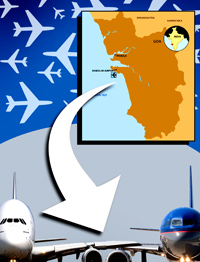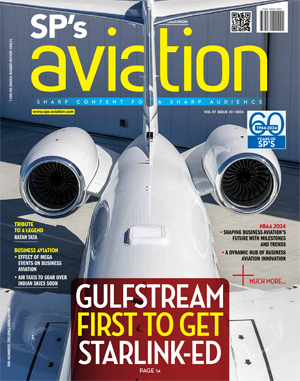INDIAN ARMED FORCES CHIEFS ON OUR RELENTLESS AND FOCUSED PUBLISHING EFFORTS

SP Guide Publications puts forth a well compiled articulation of issues, pursuits and accomplishments of the Indian Army, over the years

"Over the past 60 years, the growth of SP Guide Publications has mirrored the rising stature of Indian Navy. Its well-researched and informative magazines on Defence and Aerospace sector have served to shape an educated opinion of our military personnel, policy makers and the public alike. I wish SP's Publication team continued success, fair winds and following seas in all future endeavour!"

Since, its inception in 1964, SP Guide Publications has consistently demonstrated commitment to high-quality journalism in the aerospace and defence sectors, earning a well-deserved reputation as Asia's largest media house in this domain. I wish SP Guide Publications continued success in its pursuit of excellence.
Jostling for Space in Goa

NEWS
A Moscow-bound Trans Aero Jumbo aircraft and a UK-bound Iber World chartered plane brushed against each other at the Dabolim airport, Goa on November 16 last year. The incident occurred at around 1.30 pm. The collision affected 10 of the scheduled 35 flights as their wait for a parking bay was delayed by 30 to 45 minutes, stranding hundreds of passengers. Domestic flights were scheduled to begin by 1.30 pm. We had to accommodate them and asked the Boeing 747 to shift to another bay to make parking space for domestic flights. As the plane was taxing, its wing tip hit the tail of the A330 parked at another bay, Airport Director Paul Manickam told the reporters later on.
VIEWS
In a déjà vu of sorts, the incident occurred close on the heels of the wings of two aircraft brushing against each other at the Mumbai airport just a few days earlier. In this particular case, there were numerous and mostly conflicting reports appearing in different newspapers. However, if Airport Director Manickam’s version is to be believed, then it was a taxing accident within the confines of the civil apron at Goa’s Dabolim airport with no passengers onboard, thankfully, in either of the aircraft. While a probe has been ordered and DGCA representatives have already visited the site to delve into the circumstances leading to the accident and fix responsibilities for the same, ground accidents of such nature can occur only due to gross negligence of the involved parties – in this case, Dabolim airport authorities and the crew of the Trans Aero 747.
The airport at Dabolim, Goa is essentially a defence airfield belonging to the Indian Navy. However, in the absence of a civil airport in the vicinity, civil flights are also permitted to operate from this airfield. In the past, there were only a handful of daily civil flights operating from Dabolim. However, with Goa emerging as a major international and domestic tourist attraction, civil flights to this airfield have rapidly multiplied in recent times. At present, the airport handles as many as 85 flights a day during the tourist season, but has woeful infrastructure—a tarmac of comparatively miniscule size and an equally inadequate passenger handling terminal. For instance, tightly squeezed into the tarmac are six to nine parking bays meant only for narrow-body small airliners of the Boeing 737 or Airbus A320 class; inexplicably, there are no separate parking bays for the wide-bodied Boeing 747 or Airbus A330.
On the day of the collision, the Iber World A330, which had ingested a bird in one of its engines during landing in the morning hours, was being attended to by technicians causing an unscheduled halt and, according to Manickam, was occupying two bays. This could have been one of the key reasons for the accident as the pilot of the jumbo, in all probability, tried to taxi the aircraft without recourse to taxi-line markings for an aircraft of its size—a potentially dangerous manoeuvre that goes against the very basic tenets of flight safety.
To ease matters for civil aviation, the navy has very grudgingly parted with 6.5 acres of its own land to increase the size of the tarmac but that would be room enough for only two more aircraft parking bays and nowhere near adequate for the ever increasing civil air traffic. The navy, on the other hand, may perceive the growing civil traffic as an intrusion and inimical to its own air operations. INS Hansa, the local naval air station, operates a sizeable number of different types of aircraft, including jet fighters, helicopters and mammoth maritime reconnaissance aircraft.





